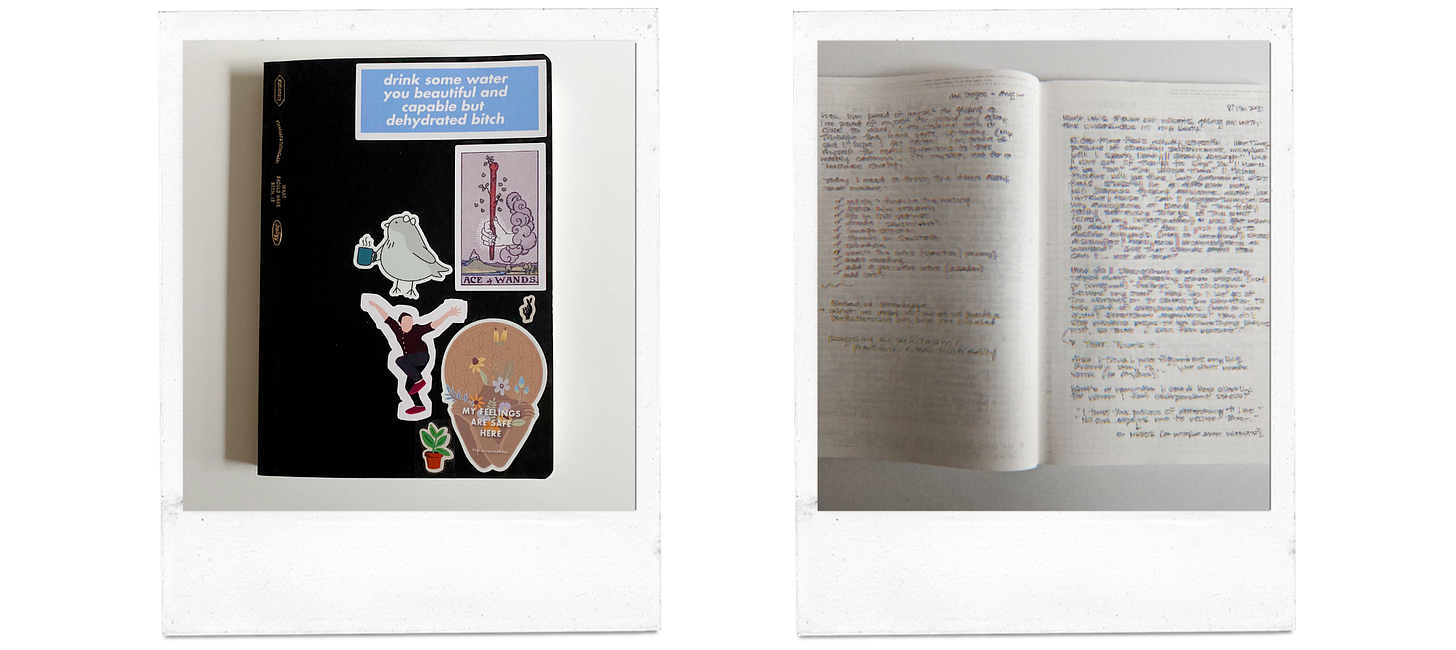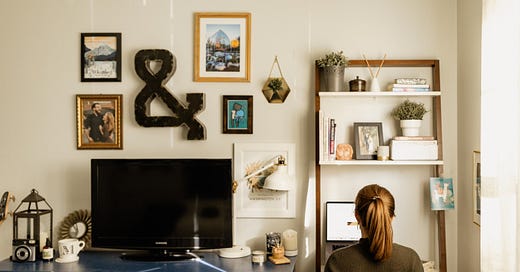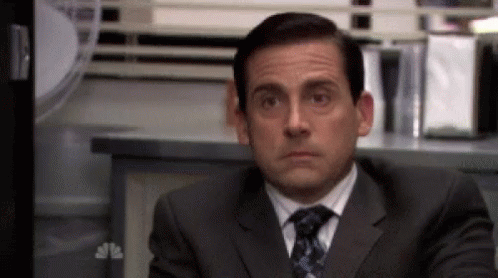A tour through my note-making ecosystem
Examples and products from my personal knowledge management system, plus questions to consider for building your own
The Webs We Weave is a free weekly newsletter on being in flux, staying connected to ourselves and our creativity, and feeling more connected in the world.
If you’d like to support this space, consider becoming a paid subscriber, sharing excerpts of this essay on social media, or forwarding it to a friend. 💛 Thank you for being here!
As a voracious learner, I appreciate new ideas—but it’s examples that really make my brain light up.
If I’m sitting in a class or a workshop and I hear the phrase, “Let’s look at some examples…” I spontaneously become this gif.
In that spirit, I wanted to try something a little different this week. Recently I’ve been thinking and writing about note making, about what happens in my body when I don’t make notes, and how I approach stewarding my personal garden of notes and ideas.
Instead of my usual essay-style newsletter this week, I wanted to share an actual tour of what my personal notes garden looks like these days, and the role it plays in daily life.
Some people might call this collective ecosystem of notes, ideas, and tools part of a “second brain” to borrow Tiago Forte’s language. Some might call it a personal knowledge management (PKM) system, and others might call it a notes and ideas garden. I’m personally still playing and learning what language I like to use, and it continues to shift.
Regardless of the semantics that feel good for you, I love the thought that this might spark ideas or possibilities for you as you consider what a note making ecosystem could look like in your life, and what you might want to create!
Heads up: this is a longer post, with plenty of pictures and bullet lists. (🤩) Let’s get right to it.
There are a few specific containers that exist within my notemaking ecosystem.
There was a time when my perfect-fit personal knowledge management system meant having one notebook to hold all the things, and that level of simplicity was exactly what I needed at the time. In the years since, my system has evolved organically and I now maintain a few specific containers for my notes.
Some of these containers are are analog, and some are digital. Some are tidy and optimized for finding what I need later, and others are decidedly messy and unrefined. Each one tends to house something a little different, and without relying on rigid or dogmatic constraints about what belongs where, I find that I naturally reach for different vessels depending on what mood I’m in, and/or what I’m capturing or processing.
The containers that make up my current notemaking ecosystem, in no particular order, are:
The Weekly Planner

The way I use a planner these days actively rejects rigid planning and overly-ambitious to do lists. Rather, my planner gives me a flexibly-structured way of staying anchored in the present.
My relationship with my planner is practical and honest, with a focus on capturing snippets of real life as I'm living it. It’s about documenting the novel and the mundane in equal measure. And as I fill the weekly spreads, I do so with an awareness that end-of-the-year me will likely flip back through the pages for an honest, unsanitized reminder of what everyday life looked and felt like during this particular chapter.
My planner holds things like:
To-do menus for the week
Short-term tasks that crop up
Fleeting reminders and lists that need to be captured for short-term retrieval
Events and appointments I’ve blocked off time for
The occasional brainstorm list for projects that tug at my attention
—
The Buddy (2.0)

This is the closest thing to my “Buddy” in its original form, in that it’s probably the thing I reach for most when I want to make analog notes about something but I’m not quite sure where to put them. I think of this as the notebook that best reflects what my brain finds sparkly in a particular season, and where my creative attention is at any given moment.
One of the primary roles it plays it to be my trusted companion whenever I’m learning something new, taking a course, watching a workshop, etc. (which is often!) and I want to take notes or make lists to stay engaged in ‘learn mode.’ I also keep a bullet journal-style index at the front which acts like a table of contents and helps me refer back to these notes later if I want to.
My Buddy holds things like:
Tarot spreads
Notes about things I’m learning
Reflections on topics I exploring
Brainstorm notes + lists for projects I’m thinking about
—
The I-Will-Never-Reread-These-Pages Journal

This is where I know I can show up unfiltered and unrefined, to offload without self consciousness or judgment. This is the notebook I reach for when I notice my brain starting to feel crowded, loud, or frantic-full. And the writing that happens here is entirely process-oriented—which is to say, I can freely vent, explore, question, confess, untangle, and find my way with the comfort of knowing that once a page is full, I’ll flip to the next without looking back.
My journal holds things like:
Morning pages (when I do them!)
Long-form brain-dumping and “release valve” writing
Stream-of-conscious-style investigative writing
Anything that needs to get out of my head that feels tender, or that I’m tempted to judge myself
—
My Let-It-Be-Ugly Notebook

This is the notebook that best scratches the, “I just need some scrap paper real quick” itch. This is my free-to-get-messy space, and anything I write in here is 100% process oriented and can usually be tossed or forgotten about the second I’m done with it (either in theory, or in practice). I come here to be un-self-conscious, to scribble things out, to give my messy thoughts space to spread out and work themselves out in space. Unlike my journal, the stuff that lands in here feels FAR less intimate and charged, and much more practical.
The paper is a great size—there’s a mix of lined, dot grid, and blank pages to choose from (I use makeshift tabs to separate the different sections), and the thickness of the notebook itself has a really satisfying tactile effect when I just need to get ugly-creative and brainstorm on the page.
My let-it-be-ugly notebook holds things like:
Diagrams and quick sketches
Rough lists
Quick math
Fleeting notes that are hyper relevant in the moment, and become obsolete very quickly
Any type of note I could crumple up and throw away immediately after writing it, without hesitation
—
My Writing Inbox

This is the one digital component in my otherwise-analogue garden of notes, and its role is both distinct and special. As much as I’m a pen and paper gal, there does come a point where easy searchability and retrieval become important to me.
I come to my writing inbox every morning (Monday through Friday at minimum) as part of my creative practice, to tease out my ideas and shape my point of view on the topics I’m most interested in—and with the intention of publishing at least some of the writing that happens here. While I show up to my writing inbox knowing full well that much of the writing that happens here will never see the light of day, I also know it’s my bridge to the pieces I’ll wind up publishing.
A major benefit of the digital aspect here is the ability to seamlessly keep track of reference material, link connected pieces of writing together, and to see unexpected connections emerge.
My writing inbox holds things like:
Links and references to content I’m consuming
Ideas I’m exploring
Drafts of essays yet to be published
A wellspring of bookmarks to other pieces of writing that inspire me
In general I try not to think too hard about where any one note should go—or at least, I try not to let that decision become unnecessary friction that stops me from writing the thing down.
Typically a clear-enough answer emerges when I consider the purpose of the note I’m about to make. (How likely am I to want to find or reference this again? How tender does this feel, and/or how self-conscious do I feel about getting it down on paper? Do I just need space to be messy? Does this feel like something that could become an essay?) But again, I now know I don't have to know where an idea will lead or what purpose a note will ultimately serve for it to warrant being planted somewhere.
The most important thing is to trust my system to hold the ideas that resonate, and to trust myself to know when and how the system needs to adapt to meet my needs. If I don’t trust my system, I won’t use it—and I find that’s when things start to feel untenable and loud in my mind.
The best way to know whether, when, and how a system needs to adapt is by using it—and then paying attention to how it feels.
Some questions you might ask yourself, as you start dreaming up the specifics of your own note making ecosystem:
What are the types of things you find yourself capturing—or needing to capture—most often? (i.e., random little tasks you need to remember? shower thoughts? ideas for essays? notes as you’re consuming other media?)
What do your natural tendencies look like when a thought or idea strikes? (i.e., do you intuitively reach for your phone to jot something down? Is your workspace covered in little post-it notes with reminders on them? Do you have a notepad that’s already filled with pages of random lists?)
What’s working about your current way of doing things?
What are you missing or craving within your current way of doing things?
If you fully trusted yourself to iterate as you go and to eventually find your perfect-for-you system… what could the simplest, minimum viable starting place look like?
Keep in mind that I absolutely, 100% did not start with this exact version of the system I just walked you through. In fact, I started with the simplest system there is: a single notebook to rule them all. Layers of complexity and other tools were layered in organically over time in response to friction I noticed, the gaps I found, and what I felt called to tweak—and those specifics are all very, very specific to me.
Similarly, you’ll need to find what works for you, specifically.
If I can offer you one word of advice out the gate: start simple, and be willing to trust yourself to iterate over time. Going from zero to complex is a recipe for confusion, fatigue, and system-abandonment. But iterating slowly in response to your own needs, rhythms, dislikes, quirks, and preferences is how you’ll build something that’s tailor-made for you, and that’s likely to stick for as long as you want it to.
Don’t let the specifics of the perfect system bog you down. It’s about what happens inside the system that really counts.
On that note, I’ll leave you with these wise words from Fanny Priest:
“Whatever planner system I use—because it delights me and gives me joy to use one—will need to accommodate the ever-evolving needs of this joyously unruly, deliciously rebellious body that capitalism & white supremacy cannot own. In abandoning the idea of a perfect planner system, I can embrace my becoming and evolution, moment by moment. I can create and invent a new way of being out of paper and pens and paint and stickers and stamps.”
🔖 Bookmarking
I referenced it above, but
’s essay on New Planner Fever is one of my favorites, and one I refer back to often. I particularly love the way she explores the tension between the sparkly veneer of planner culture vs. the extractive nature of the hustle-and-grind culture that underpins it:“Our journals and planners can be a space in which we practice liberation, in which we imagine, and experiment towards, a vision of time that is slow, messy, expansive, and that serves to interrogate and interrupt internalized capitalism and white supremacy.”
🍁 Drawn To
…more meatless meals! In our house we’ve sort of organically started moving more and more in this direction anyway, but especially as fall rolls in I’m looking forward to experimenting with more seasonal-veggie-forward soups, stews, sheet pan meals, etc. (Related: this cookbook ranks HIGH on my wishlist right now.)
💭 Still Thinking About
was kind enough to put onto my radar for the first time this week by way of her newletter , and now I have to pay it forward. I DEVOURED this essay (below), followed soon after by this one and this one.
✨ Weekly Dose of Internet Delight
Until next time,
Michelle











Love getting a window into your system, Michelle!
Also, for the last few years I’ve aimed to be mostly vegetarian. If you haven’t come across it already, the most reliable cook-all-the-time recipes I’ve found have been from https://cookieandkate.com